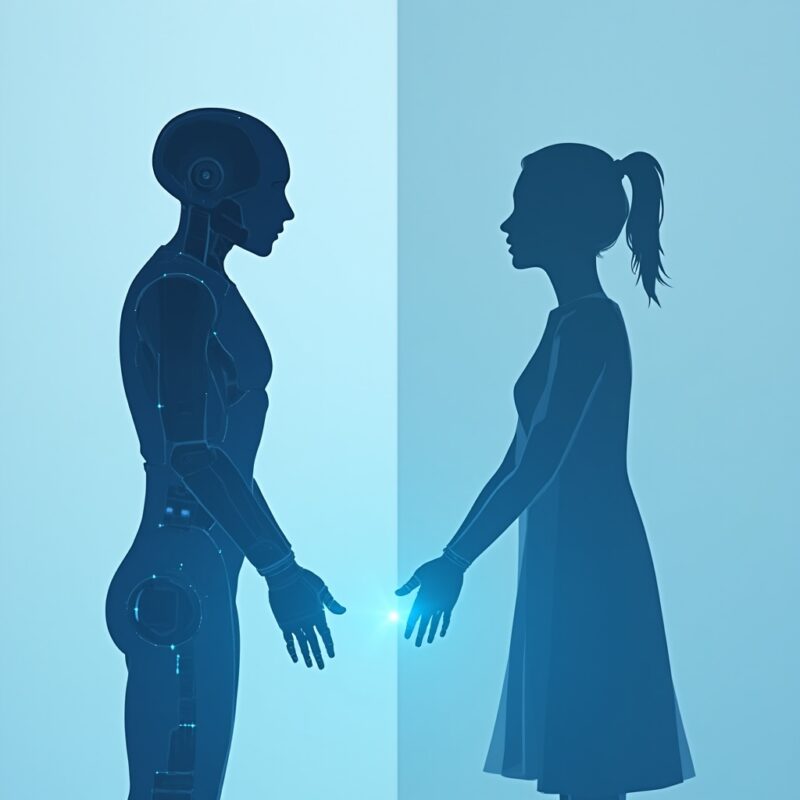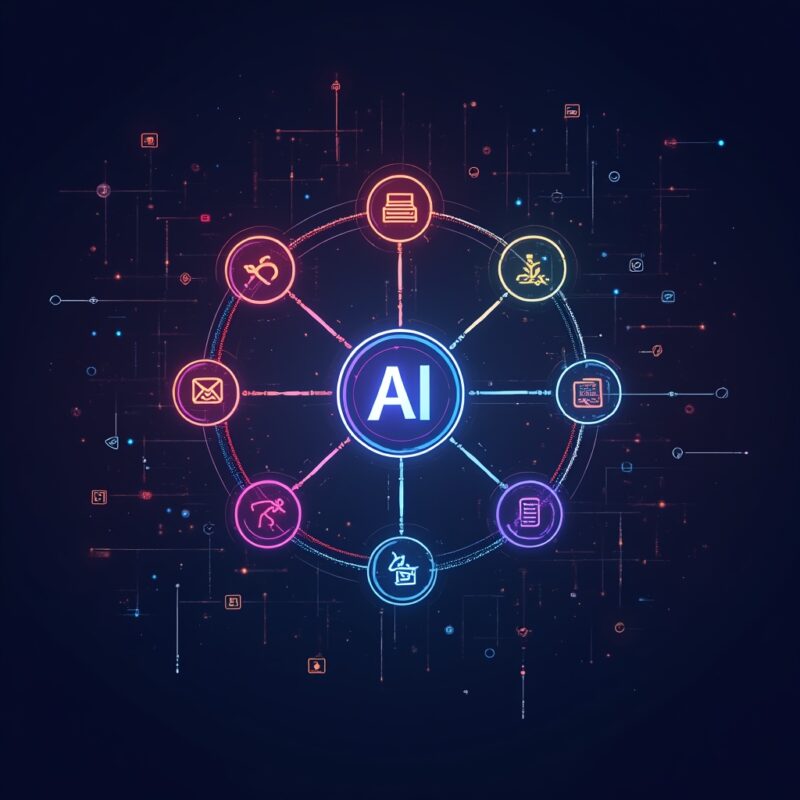Humanize AI: Techniques for More Natural AI Interactions

Humanizing AI involves techniques like conversational prompting, emotional intelligence integration, and context-aware responses that make interactions feel more natural. Implementing personalized language patterns, subtle imperfections, and responsive feedback systems helps bridge the uncanny valley, creating AI experiences that complement rather than replace human connection.
When AI Started Feeling Like My Awkward Cousin at Family Dinners
Last week, I asked my smart speaker to add oat milk to my shopping list, and it replied with all the warmth of a DMV automated system: “I’ve added oat milk to your shopping list.” I couldn’t help but sigh. Remember when we thought future robots would be like Rosie from The Jetsons? Instead, we got glorified calculators that occasionally tell dad jokes.
But here’s the thing – AI doesn’t have to feel like talking to a particularly enthusiastic vending machine. The gap between robotic interactions and genuinely helpful, natural conversations is closing fast. Companies are finally realizing that making AI feel more human isn’t just about better technology; it’s about better relationships with the technology we already have.
And honestly? It’s about time. I’m tired of apologizing to my voice assistant like I’m talking to a toddler who only understands single-syllable words. Let’s break down how we’re finally teaching our digital friends some social skills…
What Does “Humanizing AI” Actually Mean?
Humanizing AI doesn’t mean creating convincing digital people who’ll eventually overthrow humanity (despite what my dad thinks after watching too many sci-fi movies). It’s about designing AI systems that communicate and interact in ways that feel natural, intuitive, and occasionally delightfully imperfect – just like talking with another human.
At its core, humanized AI focuses on three key elements:
- Natural communication that flows conversationally rather than feeling like you’re talking to a search engine
- Emotional intelligence that recognizes and appropriately responds to human feelings and contexts
- Personalized interaction that remembers your preferences and adapts to your communication style
The goal isn’t to trick you into thinking you’re talking to a human (that’s gettin’ into creepy territory). Rather, it’s about creating interfaces that don’t constantly remind you that you’re interacting with a machine.
Why Humanized AI Matters More Than Ever
Remember the first time you used a chatbot that kept misunderstanding your questions? That frustration you felt is exactly why humanizing AI matters. As digital interactions become more embedded in our daily lives, the quality of those interactions directly impacts our wellbeing and productivity.
Research from the Stanford Human-Centered AI Institute shows that users are 67% more likely to continue using AI systems that demonstrate human-like communication patterns. It’s not just about preference—it’s about effectiveness.
The Psychological Impact
When AI responses feel mechanical and rigid, they create cognitive friction. Your brain has to work harder to translate between “human speak” and “computer speak,” which is mentally exhausting. This is especially problematic as we face:
- Increasing digital isolation in remote work environments
- Growing reliance on AI for customer service and information
- Technology adoption barriers among less tech-savvy populations
Humanized AI helps bridge these gaps by meeting users where they are, rather than forcing users to adapt to the machine’s limitations.
Learn more in
N8N Workflow: Building Powerful Automations Step-by-Step
.
Practical Techniques for Humanizing AI Interactions
1. Conversational Prompting
The way we “talk” to AI systems dramatically influences how they respond. Instead of rigid command structures, developers are implementing more flexible, contextual prompting techniques:
- Zero-shot prompting: Allowing the AI to respond to completely new scenarios without prior examples
- Few-shot prompting: Providing a handful of examples to guide the AI toward more human-like responses
- Chain-of-thought prompting: Encouraging AI to “show its work” in a way that resembles human reasoning
For example, instead of programming strict response templates, modern systems are trained to maintain conversation history and respond contextually – just like you’d expect in a human conversation.
2. Emotional Intelligence Integration
The most sophisticated AI systems now incorporate emotional awareness through:
- Sentiment analysis that can detect frustration, confusion, or satisfaction in user inputs
- Adaptive responses that match the emotional tone of the user (being more formal or casual as appropriate)
- Empathetic acknowledgment that validates user feelings before moving to solutions
I recently interacted with a customer service AI that noticed my frustrated tone and immediately offered to connect me with a human agent instead of continuing to troubleshoot. That kind of emotional awareness makes all teh difference between a positive experience and wanting to throw your phone across the room.
3. Interface Design That Feels Human
Humanization isn’t just about language—it’s about the entire interaction experience:
- Virtual avatars with subtle, natural movements that avoid the uncanny valley
- Voice modulation with micro-imperfections like brief pauses or slight variations in tone
- Response timing that mimics human thinking patterns rather than instant replies
The most effective systems even incorporate “thinking time” before complex responses, reinforcing the collaborative nature of the interaction rather than presenting AI as an all-knowing oracle.
Common Myths About Humanizing AI
Let’s clear up some misconceptions that keep popping up in conversations about humanized AI:
Myth #1: Humanized AI is just about making chatbots sound casual
While conversational tone is one aspect, true humanization involves deeper architectural changes that allow for contextual understanding, memory of past interactions, and adaptive learning based on user preferences and behaviors.
Myth #2: The goal is to make AI indistinguishable from humans
Absolutely not! Ethical AI development emphasizes transparency about when you’re interacting with AI. The goal is to make the interaction feel natural and efficient, not deceptive.
Myth #3: Humanized AI is just a marketing gimmick
Companies investing in humanized AI consistently report higher user satisfaction, improved task completion rates, and stronger brand loyalty. The business impact goes far beyond surface-level appeal.
Myth #4: You need massive resources to humanize your AI
While cutting-edge systems do require significant investment, there are accessible techniques that smaller organizations can implement to make their AI interactions more human-centered without breaking the bank.
Real-World Examples That Actually Work
Enough theory—let’s look at some implementations that successfully bridge the human-AI gap:
Customer Service: Lemonade Insurance
Lemonade’s AI claims handler, Maya, communicates in a conversational manner, uses appropriate emotional cues, and knows exactly when to hand over complex cases to human agents. Their claim process takes minutes instead of days, with a satisfaction rate that outperforms traditional insurance companies.
Healthcare: Woebot
This mental health chatbot uses carefully crafted language patterns, acknowledges its limitations, and incorporates evidence-based therapeutic techniques. Rather than pretending to be a human therapist, it positions itself as a helpful tool with a distinct personality, making mental health support more accessible.
Education: Duolingo Characters
Duolingo’s cast of characters demonstrates how humanized AI doesn’t have to mean hyper-realistic. Their cartoon owls and bears exhibit consistent personalities, make occasional jokes, and even show appropriate disappointment when you miss lessons—creating emotional investment without attempting photorealism.
Daily Assistance: ChatGPT
While not perfect, ChatGPT demonstrates sophisticated conversational abilities, maintaining context across exchanges, admitting uncertainty, and explaining its reasoning in human-understandable terms. Its ability to adapt to different conversation styles and adjust its tone accordingly represents a significant leap in humanized AI interaction.
Learn more in
N8N Workflow: Building Powerful Automations Step-by-Step
.
What’s Next in the Human-AI Relationship?
As we look toward the future, the focus is shifting from “Can AI sound human?” to “Can AI collaborate with humans in meaningful ways?” The most promising developments include:
- Multimodal understanding where AI can integrate visual cues, voice tone, and text context simultaneously
- Cultural adaptation that respects different communication norms across global contexts
- Long-term memory models that build genuine relationships with users over time
The north star isn’t creating artificial humans—it’s creating technology that complements our humanity rather than asking us to become more machine-like to accommodate its limitations.
As these systems evolve, the line between automation and augmentation continues to blur. The most successful implementations will be those that enhance human capabilities without attempting to replace the irreplaceable aspects of human connection.












